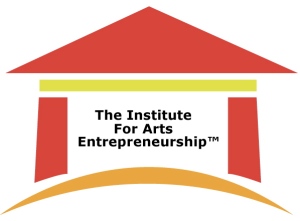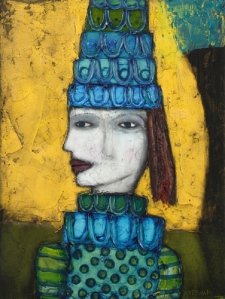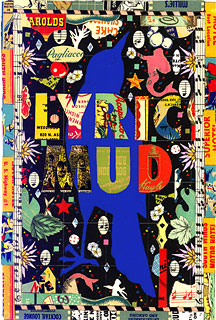 Bite-Size Arts Ensemble Member, Dharmesh Bhagat, built this blue bike out of balloons for me. Isn’t it cute? What does your blue bike look like? Do you know? And what does it mean to build a blue bike anyway?
Bite-Size Arts Ensemble Member, Dharmesh Bhagat, built this blue bike out of balloons for me. Isn’t it cute? What does your blue bike look like? Do you know? And what does it mean to build a blue bike anyway?
To me, the journey of learning how to take the pain in your heart and transform it into an entrepreneurial vision that is so strong and robust it produces an economic engine in your life- financial transportation- is what I call building a blue bike. It is impossibly difficult to do alone and requires an undying amount of support from others to accomplish. And I want you each to know how grateful I am, that you have been here for me on my own blue bike building journey.
Ever since I wrote my book, Build a Blue Bike, the pain in my heart has only grown. While I was very lucky to land a big agent, Susan Schulman, who represented Economist, Richard Florida’s Rise of The Creative Class, my timing could not have been worse. As we entered into a Big Big Recession I was trying to sell this book…..
I still hold out hope that someday I will hear back from Tarcher- my dream publisher. Julia Cameron: Artist Way- continues to be a big hit for The Tarcher Publishing company. So currently my manuscript resides in the back of my sock drawer, while my deep desire to help artists transform from the inside-out continues to grow.
My pain comes from a lifetime of artistic experiences that one-by-one drove me to become incredibly cautious and careful around artists because of the dysfunction I experienced trying to share the music in my heart with them. It was the drama, self-destruction, withdrawal, denial, arrogance, insecurity, back stabbing and anger I saw in others that made me take the joyful music inside my heart and lock it away. This was not what tickled my funny bone and called my artistic name to the clarinet and it is not where artistic entrepreneurial vision comes from. As a child, it was a love for exploring my own artistry and sharing my creativity with others that seeded my entrepreneurial abilities.
And it broke my heart to pull away from my deepest desires to play the clarinet for my life’s work when I was at the top of my musical game, at the end of my days as a college student at Northwestern. I truly wanted then and still want to share my creativity intimately with others. And while I went on to build creative ventures over the past twenty- years, creatively finding a way to put my need to play my clarinet each time at the center of my ventures, my heart continued to feel pain.
So after twenty years of living with my pain it grew so strong and loud, I wrote Build A Blue Bike hoping if I did something positive about it- by writing a book to share with others what only my artistry and unique vision blended together can see- it would help others heal and the pain I felt would finally subside. But the pain did not stop. So when Build A Blue Bike did not sell to a major publisher, my dream and hope for it still, I created Entrepreneur The Arts®. But it was still not enough.
From there came The Bite-Size Arts Ensemble™ and somehow, as this ensemble has struggled to take flight, I realized that while the pain inside of me was duller and throbbed less, as my vision for what I could do with it was growing stronger and clearer, it was still inside of me. I know that our show What is Your Imagination Worth? A New Kind of ROI is going to really help those who experience it learn about how they can change, evolve and grow. But I need what my audiences learn about developing their imaginations, to become something real: something that nourish their hearts and others souls. Something made to last. Maybe even forever- or for at least a lifetime on this earth.
And now, finally, last night, at Flourish Studios, with Stanley Drucker in the house, The Institute for Arts Entrepreneurship™ has been born. Finally, after three and a half years of struggling, I feel like I have found the ignition key for my vision and a turning point for my heart to begin its work of healing.
You see, I want so badly to help you to discover your own vision, like I have. I want your deepest pain in life to become a vision of what you can positively change in the world that will help you create an artistic life filled with meaningful opportunities for you, and others, to learn from and endlessly grow. I know you will be happier and emotionally healthier the moment you decide to. I know when more of you are living a LIFE YOU DREAM that the dysfunction I see in the arts will slowly, but surely, change. I still so want to experience what our shared positive creativity and artistry can do for this world. Don’t you?
So what does it take to build your very own blue bike? One that will last forever, and ever, or as long as your vision can see, and until the pain in your heart has been nourished into health?
OK. If you are brave enough to consider trying to, here are a few things you have got to know:
#1 However long you think it is going to take to transform the pain in your heart into entrepreneurial vision– know that building a meaningful creative venture- one that is built to last- requires a large investment of time– at least a couple of years if not more.
#2 You need to be willing to set aside your need for clarity and perfection and be able to live with a tangled web of ideas at first- a mess- in the development stage of your personal transformation. Turning pain into vision is a process that is not neat and tidy. And you need excellent role models to help you navigate through so you find the most expeditious way. Nothing short will do. The bigger the pain the greater the vision can be and the longer it can take for your artistic vision to become clear and focused and financially able to take flight.
#3 You must be willing to continuously attempt to launch your ideas into the world knowing that you will need repeatedly to rebound from many failed attempts until you finally find some traction for them. You will be laughed at, ignored, disrespected, ridiculed, slighted and humbled by this process every single time it happens– until your vision is perfectly aligned with the pain in your heart and it ignites the transmission of your creative venture. And then… you will be celebrated like the hero everyone always knew you would become. (It is the hero’s journey we are talking about here. It is what has to happen for your artistry to take economic flight.)
#4 You need tenacity to fuel ideas. Consistent effort that is unwilling to stop–What is it that your heart needs most to not be in pain? Whatever that is, there lies the endless source of your tenacity.
#5 You need to be or become a great collaborative communicator. When we share our vision and receive feedback from others about it, we learn how we are being perceived. When we get it right, our vision will manifest itself into economic opportunities that seemingly will pop right up out of nowhere– and become our transportation into our future.
#6 And lastly, you need to have excellent ethical judgement. What goes around comes around. If you do what’s right every single time, eventually you will be rewarded. And if you do what is right and true for you, eventually your heart will feel whole and your ideas will roll and the money will flow…
#7 Remember–Where there is money, there is energy and where there is energy there is a lifetime of economic opportunity…
And politics aside- Isn’t this really what Obama keeps telling us? This IS our moment. WE are the future of history. OUR time has come. It is Now. Are you Ready?

 Join and Cast Ventures: Two Art (Intermedia) students, Jennifer C. and Catherine A., are producing a field guide to the downtown Phoenix arts scene that is itself a work of art.
Join and Cast Ventures: Two Art (Intermedia) students, Jennifer C. and Catherine A., are producing a field guide to the downtown Phoenix arts scene that is itself a work of art. Radio Healer: Led by Arts, Media Engineering (AME) graduate student Christopher M., Radio Healer presents mediated performances that foster intercultural dialogue in Native communities.
Radio Healer: Led by Arts, Media Engineering (AME) graduate student Christopher M., Radio Healer presents mediated performances that foster intercultural dialogue in Native communities. Dance and Health Together Awards: Led by undergraduate Dance major Mary P., the DaHT Awards is a combination of dance recognition award and fundraising enterprise benefiting the Susan G. Komen Foundation.
Dance and Health Together Awards: Led by undergraduate Dance major Mary P., the DaHT Awards is a combination of dance recognition award and fundraising enterprise benefiting the Susan G. Komen Foundation. Co-op Film Productions – Film and Media Production/Marketing student Chelsea R. and her team are creating a support infrastructure for student collaboration across arts and design disciplines.
Co-op Film Productions – Film and Media Production/Marketing student Chelsea R. and her team are creating a support infrastructure for student collaboration across arts and design disciplines. Different from What? Film Festival – AME graduate student Lisa T. in collaboration with Education student Federico W. is producing a film festival focused on films by, for, and about adults with disabilities.
Different from What? Film Festival – AME graduate student Lisa T. in collaboration with Education student Federico W. is producing a film festival focused on films by, for, and about adults with disabilities. Scratch Theory – Filmmaking Practices major Chris G. and his collaborators are developing a software/hardware interface that will first notate and then play back via synthesizer DJ scratching.
Scratch Theory – Filmmaking Practices major Chris G. and his collaborators are developing a software/hardware interface that will first notate and then play back via synthesizer DJ scratching.















